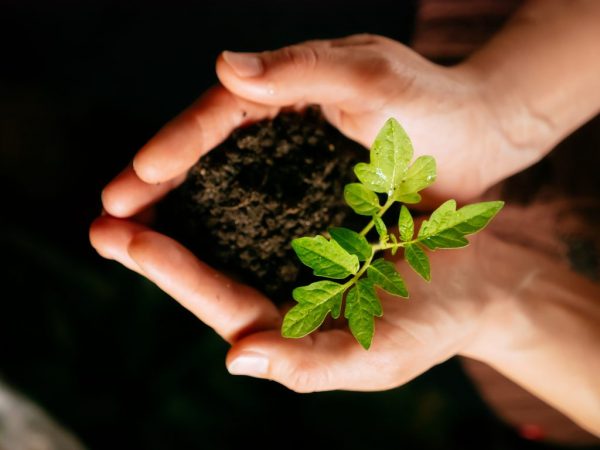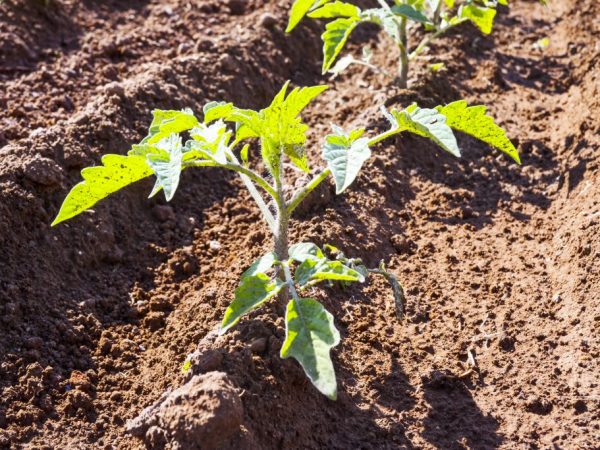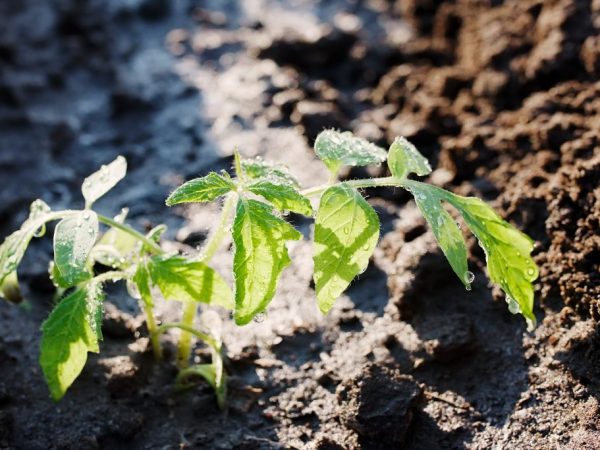What is put in the hole when planting tomatoes
To ensure full development when planting tomatoes, various dressings are placed in the hole. It can be both organic, folk and mineral fertilizers. Their main function is to nourish plants with essential trace elements such as nitrogen, phosphorus and potassium. A sufficient amount of nutrients will be the key to the fruiting and yield of the tomato.

Fertilizing a tomato during planting
Garden bed preparation
When the seedlings have grown, it is time to plant the plants in the greenhouse and open ground. It becomes necessary to prepare a bed and holes for planting. And also understand what to put in the holes when planting tomatoes to provide them with nutrients.
On a prepared and dug-up bed, we make grooves 30x30 cm in size, keeping a distance between them of about 30 cm. The bottom is well loosened so that the roots can easily take root. And also we put different top dressing for young bushes.
Organic fertilizers that can be added to the hole when planting tomatoes include:
- overripe manure;
- bird droppings;
- peat;
- compost;
- ash;
- organic residues (onion skins, eggshells).
If the use of organic matter is impossible for some reason, and fertilizing was not carried out in the fall, mineral fertilizers are used. Suitable for feeding:
- ammonium nitrate;
- superphosphate;
- complex for tomatoes.
Organic fertilizers
Organics are rich in macro- and microelements that are necessary for full growth. Acts gently and, if used correctly, will ensure stable vegetation and fruiting. And also will not harm. This type of fertilizer is suitable for feeding tomatoes both outdoors and in a greenhouse. In order to bring the maximum benefit to the plants, you need to know how and what to put in the hole when planting tomatoes.
Overripe manure
They use cow, horse and other manure. Intensive fertilization, has a good supply of trace elements to ensure growth. He must be overripe and well laid down. Until the moment of introduction, manure should be kept from 4 months to 3 years. The longer the better.

It is forbidden to use fresh manure
Humus is an ideal top dressing for autumn soil application, but it is also successfully used to put in a hole when planting tomatoes in spring. Manure must be added to the hole no later than two days before planting seedlings.
We put 50 g of manure on one bush. Cover the manure with soil so that the roots of the tomatoes do not come into contact with it. Before planting the bushes, the planting pits are spilled with water.
Humus is a concentrated nitrogenous substance, so dosage plays an important role. Exceeding it can lead to a deterioration in the quality of the soil, an excess of nitrates, and burns of the delicate roots of seedlings. It is worth remembering that putting fresh manure into the hole when planting a tomato is strictly prohibited.
Bird droppings
Chicken and pigeon droppings are used for feeding. Very concentrated fertilizer.It will be able to provide plants with a full supply of nitrogen, phosphorus and potassium for the entire season.
The best application is to spill the solution. 10 liters of water are poured into the container and 1.5 kg of manure are added, left to ferment for 5-7 days. The resulting solution is dissolved in water before use. Add 200-250 ml of concentrate to one bucket of water. For one well, 250 ml of such a solution is enough. The holes are spilled no later than 2 days before planting the tomatoes. After the addition of the droppings, additional shedding with clean water is carried out.
High concentration and activity requires careful handling.
Peat
Peat can also be used when planting tomatoes. Peat is rich in organic residues and contains humus, which improves the quality of the soil. The looseness of peat improves the structure of the soil under the plants. In light soil, it is easier for the roots of seedlings to develop, receive oxygen and nutrients. And also peat has the ability to reduce the amount of nitrates in soil and fruits. Lowland peat is used for tomatoes, it is completely decomposed. 1-2 handfuls are introduced into the hole and mixed with the soil.
The use of peat can lower the pH of the soil.
Compost
Use well-rotted compost. The composting process should take 12 months or more. A small amount of superphosphate (10 g per 100 kg of compost mass) can be added to the compost.
Under the bush, 200-300 g of well-rotted compost is introduced into the hole. This will improve the quality of the soil and be the basis for the growth of vegetable crops.
Ash
Wood ash is introduced for planting various vegetable crops and tomatoes as well. This dressing is not unreasonably popular among gardeners. The summer residents even called the ash "Stove gold". The most valuable, wood ash and ash from potato tops.

Ash will help plants grow better
We put the ash in the pits in a small amount, embed it 5-6 cm into the ground. Tomatoes respond very well to ash. They grow and bear fruit intensively.
Its important advantage is its safety and the absence of any pathogens in it.
Onion peel
Onion hulls have proven themselves well as an insecticidal preventive agent. Protects young bushes at the beginning of the growing season from thrips, spider mites, aphids. The husk serves as a disinfectant for the soil, and also protects against black legs and pests (nematodes, slugs, bear), and rotting becomes a good fertilizer for the bush.
It is enough to put one handful of dry husks in the landing hole. You can also use the infusion from the husk to spill beds or sprinkle adult plants.
Put a liter jar of onion husks in a bucket and pour boiling water until it is full. Insist for 24 hours, filter and dilute with clean water in a 1: 5 ratio. Spill the beds with this solution.
Eggshell
The eggshell is dominated by calcium (95%), which is very well and easily absorbed by plants. In smaller amounts, magnesium carbonate (2%), phosphates (2%) and organic matter.
The shell will provide the tomatoes with calcium, which is very necessary for high-quality fruiting. Eggshells tend to lower the acidity of the soil, which is also important for the growth of tomatoes.
Eggshells are brought in, after washing and drying well. Then it is ground into powder. For one bush, it is enough to put about two teaspoons of the powder.
Mineral fertilizers
Industrial fertilizers are rarely used for laying in holes. But this option also takes place in agricultural technology.
Ammonium nitrate
It is possible to apply the substance in granules or in an aqueous solution in spring both in open ground and in the soil in a greenhouse. For one bush, it is enough to put 1 tbsp. l. pellets into the planting pit. Or dissolve 30 g in 10 liters of water and shed it, so the nutrients will quickly get to the plant. Nitrogen predominates in nitrate, which contributes to a set of green mass and growth.
Superphosphate
Superphosphate promotes root development and accelerates development. For one plant, it will be enough to add 1 tbsp. l. granules. It is important to remember that, having chosen superphosphate for feeding, you cannot add saltpeter at the same time.
Complex fertilizer for tomatoes
A very good option in the case of using chemicals for feeding tomatoes would be a special complex fertilizer (for example, Kemira Universal). It is formulated specifically for tomatoes. The ratio of useful trace elements in the complex is 12: 6: 18 (NPK), which is ideal for the development of nightshades. The amount is calculated following the dosage indicated in the instructions. Average 30 g / sq. m. or 8-10 g for one bush.
A complete complex will provide the culture with all the necessary microelements. This fertilizer can be used throughout the entire period.
Conclusion
For feeding tomatoes by placing nutrients in the hole, it is better to choose organic fertilizers. They are safer and do not harm the environment. And adherence to the correct dosage will help you grow delicious vegetables without exceeding nitrates.


